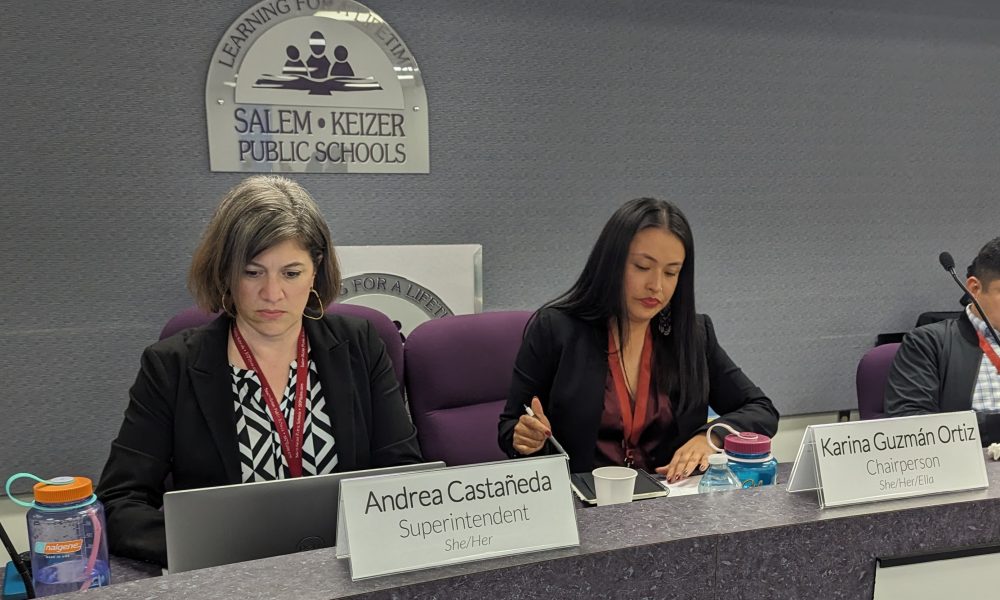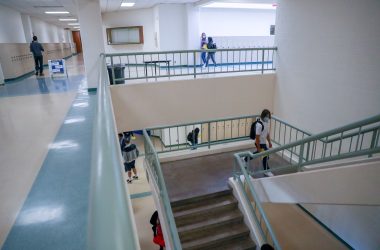The Salem-Keizer School Board on Tuesday unanimously approved a plan to lay off hundreds of teachers and educators next school year as part of a $71 million budget cut plan that will reduce services for the district’s 40,000 students next year.
The cuts are intended to keep Oregon’s second-largest school district financially healthy as federal Covid relief money expires and state school funding has not kept pace with inflation.
Which jobs will be cut
- 15 administrators, most working in district positions, and a few in schools — 13.1% of all district-level administrators, and 4.9% of administrators working in schools
- 139 full-time classified jobs, including 71 vacant positions — 4.9% of the district’s classified workforce. Jobs cut include classroom assistants and hours for school health workers.
- 239 full-time teacher jobs and other licensed positions, 39 of them vacant — 8.8% of the district’s teacher workforce. Jobs cut include 70% of instructional mentors, who mentor teachers at schools, and program associates, teachers who work district-level jobs like curriculum.
School board directors voted after meetings Monday and Tuesday, where Superintendent Andrea Castañeda and other district administrators laid out their plan. The board resolution calls for cutting up to 15 administrators, 139 classified positions like classroom assistants, and 239 teachers.
About 100 of the 400 positions that will be cut are currently vacant.
“We do all of this with a heavy heart but also with a sense of responsibility because we must safeguard the future of our district,” Castañeda said as she presented the plan Monday.
“It’s difficult, it’s emotional, it’s heavy,” Board Chair Karina Guzmán Ortiz said during the Monday meeting. “The cuts are painful, far from anything we want to do, and we do understand it’s necessary as well.”
Among the cuts proposed are reducing school health assistants, who administer medications to students, to the pre-pandemic staffing level of two hours per week, and cutting 70% of district instructional mentors, experienced teachers who help mentor newer teachers.
District leaders said the cuts won’t directly reduce staff for dual language programs, sports, arts, music, advanced high school courses, counselors, social workers, security and career education programs.
They are also working to minimize the impact on elementary school class sizes, said Olga Cobb, deputy superintendent for elementary schools. That means class sizes in middle and high schools are likely to increase next year.
Teachers, parents, students and other district employees who spoke at the meetings urged the school board to preserve positions working directly with students.
Heather Rutkowski, a teacher at Crossler Middle School, asked the board to demand an organizational chart from district leaders and examine every employee who doesn’t work directly with students.
“I would like you to question why every single one of those non-building level, student-facing positions is more vital to the educational success of Salem-Keizer students than the positions her team has chosen to eliminate,” Rutkowski said.
Cobb said in response to public feedback to an initial round of budget cuts announced in December, the school district will keep two additional school nurses employed. Castañeda’s original plan called for cutting five registered nurses.
With cuts made, Castañeda said the district expects to spend $579 million next year and bring in $560 million in revenue. While that doesn’t close the budget gap entirely, the superintendent said it goes a long way toward restoring financial health after several years of spending more than schools brought in.
The district will end the year with about $67 million in savings — enough to cover about six weeks of expenses.
“We have heard from commenters tonight and we feel in our own hearts the same feeling that these reductions are not right,” Castañeda said Tuesday. “This is not the right time, this is not the right place. And at the same time, we do not have enough money in our system to continue as we are. We need to work to change that. That is urgent work for us, but it is not money we have now, nor is it money we will have next year. That leaves us with no good options.”
Why Salem-Keizer is facing cuts
The cuts are the result of several compounding factors that mean school districts across Oregon will have far less money next year than needed to keep current employees.
A key factor: state analysts significantly underestimated how much it would cost Oregon school districts to keep the same number of employees from 2023 to 2025.
Legislative analysts predicted the cost of employees would rise just 5.45% over two years, a number the Oregon School Boards Association called “woefully inadequate.”
Salem-Keizer’s employee costs are expected to rise 14% in that period due to wage increases and rising health insurance costs, according to an open letter school board directors published in March.
“It was a grave calculation error, and it’s not just Salem-Keizer,” Castañeda said.
State lawmakers used the low estimate to determine how much money schools get through the state’s school fund — the largest source of operating money for districts.
The result is that the $10.2 billion allocated statewide — money which was intended to keep current services — instead has districts making large cuts. Portland Public Schools is considering $30 million in budget cuts next year.
“The story we’re telling today is not about staff being overpaid. It is not about having too many staff. It is a story about not having enough state funding to support the needs of our school system,” Castañeda said at the Monday meeting. She added that district workers deserved “every cent” of the raises they recently secured in new contracts.
Enrollment in the district is declining, meaning the district gets less money overall from the state. But the cost per student to address educational, behavioral and mental health needs has continued to climb, educators say.
Compounding the budget problems, federal Covid relief money has boosted school budgets for the past four years, adding tens of millions of dollars to district coffers. That money expires at the end of the school year.
Salem-Keizer leaders used that money to hire dozens of employees, expanding hours for health assistants at schools and giving schools more people who worked to catch kids up on reading and make home visits to chronically absent students. The money also paid for some one-time expenses, like software and Chromebooks to help schools transition online during the early part of the pandemic.
Former Superintendent Christy Perry, who retired at the end of last school year, foreshadowed significant budget cuts when presenting the district budget last May. She said at the time she felt it was best for students to keep extra employees funded with pandemic money as long as possible to help students catch up, even if it meant painful cuts the following year.
Castañeda echoed that rationale this week.
“We need the services, we need the people but we no longer have that money,” she said.
Leaders of the district’s teacher union don’t dispute cuts are needed or that inadequate state funding is the underlying issue. But they also criticized district leaders for what they described as a pattern of using new funding to hire more supervisors, add new programs and increase overhead, then laying off more people who work directly with students when times get tough.
“Our district leadership in the past several years have made choices that have also contributed to this budgetary shortfall,” said Tyler Scialo-Lakeberg, president of the Salem-Keizer Education Association.
Before voting to approve the cuts, school board Second Vice Chair Ashely Carson Cottingham called on the board and district leadership to be more transparent with the public. She asked for an organizational chart of administrator roles so the public could better understand what’s being cut.
“I think we all need to do better. Our job of this board is to push, to provide oversight and to make informed decisions based on what the public and professionals tell us,” she said.
What happens next
With the layoff approved, district leaders will begin speaking to school principals at the district’s 65 schools as the principals begin building schedules and plans for next year.
Castañeda said district leaders will draw on feedback from principals about needs and issues to determine the exact size of the layoff.
The board authorized layoffs up to the numbers in the budget cut plan, but small tweaks may happen as district leaders dive deeper into what individual schools are planning for.
Individual employees will be notified if their position has been identified for reduction. More senior employees can “bump” junior employees from jobs under the union contract, so the impacts of the layoff will cascade across the district.
Castañeda estimated by the end, about 800 workers would be in a different job next school year.
On May 17, school will be canceled for all students and school district leaders will notify employees about their job status. Layoffs would take effect June 30.
Some employees who were laid off may be recalled if people retire or quit.
Contact reporter Rachel Alexander: [email protected] or 503-575-1241.
SUPPORT OUR WORK – We depend on subscribers for resources to report on Salem with care and depth, fairness and accuracy. Subscribe today to get our daily newsletters and more. Click I want to subscribe!

Rachel Alexander is Salem Reporter’s managing editor. She joined Salem Reporter when it was founded in 2018 and covers city news, education, nonprofits and a little bit of everything else. She’s been a journalist in Oregon and Washington for a decade. Outside of work, she’s a skater and board member with Salem’s Cherry City Roller Derby and can often be found with her nose buried in a book.









